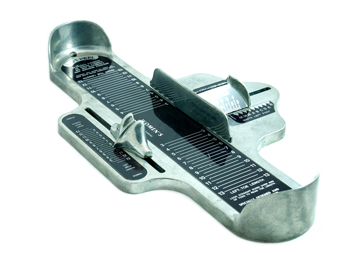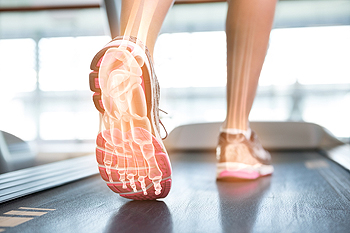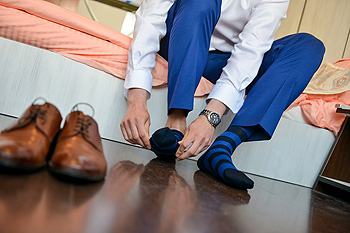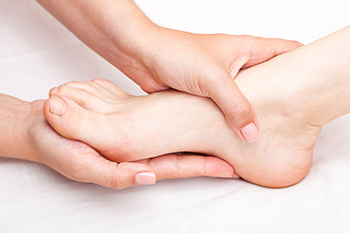(410) 764-7044
6506 Reisterstown Road, Baltimore
1205 York Road, Lutherville
6305 Belair Road, Baltimore
7809 Wise Avenue, Dundalk
October 2022
Shoes That Are Too Big, Too Small, and Just Right

There are various foot conditions that can be caused by wearing shoes that do not fit correctly. Bunions, hammertoes, and ingrown toenails are some of these ailments, and getting the right shoe size may help to prevent these from developing. It is imperative to determine what your correct shoe size is before any purchases are made. This can be done by using the Brannock device that is found in most shoe stores, which can measure the length and width of your foot. Once the size has been determined, the next step is to choose a pair that is pleasing to the eye, then try them on. This is followed by walking around in them for a short period of time in the store, which is when most people can tell if the shoe is right for them. If the shoes are too tight, they may cause blisters or corns to develop, and may need to be purchased in a half or more size larger. If the shoes are too big, they may slip on your feet, and this can increase the risk of falling. If you would like more information about how to find the right shoe size for you, please consult a podiatrist who can help you to make the right choice.
Getting the right shoe size is an important part of proper foot health. Seek the assistance of one of our podiatrists from Plaza Podiatry. Our doctors will provide the care you need to keep you pain-free and on your feet.
Getting the Right Shoe Size
There are many people who wear shoes that are the incorrect size, negatively affecting their feet and posture. Selecting the right shoes is not a difficult process, so long as you keep several things in mind when it comes to choosing the right pair.
- When visiting the shoe store, use the tools available to measure your foot.
- Be sure there is ‘wiggle room’. There should be about an inch between your toes and the tip of your shoes.
- Do not always assume you are the same size, as manufacturers run differently.
- Purchase shoes later in the day, as your feet swell as the day progresses.
- If a shoe is not comfortable, it is not suitable. Most shoes can’t be ‘broken in’, and comfort should be the ultimate goal when it comes to choosing the right pair of shoes
As our feet hold our body weight and keep us moving, it is important to treat them right. Picking the right pair of shoes can provide your feet comfort and mobility without pain.
If you have any questions, please feel free to contact our offices located in Baltimore, Lutherville, and Dundalk, MD . We offer the newest diagnostic and treatment technologies for all your foot care needs.
The Feet Are Complex, and Have Several Categories

The feet are an interesting and complex part of the body. Each foot is composed of 26 bones and several muscles, ligaments, and tendons that work together to provide mobility and balance to the body. Additionally, the feet carry the weight of the body, and are designed to absorb shock while running and walking. Research has indicated there are three types of foot postures. Humans and animals have the foot structure that is known as plantigrade, and is observed as the entire foot striking the ground while walking. The digitigrade posture is seen in dogs and cats, and is noticed as only the toes are on the ground while walking or running. Animals that run, such as horses, possess the unguligrade posture, and this is seen as a few of the toes touching the ground while running. The human foot has three parts, consisting of the hindfoot, midfoot, and forefoot. Within each foot are bones that are divided into three categories, including tarsus, metatarsus, and phalanges. There are many more parts that make up each foot, and if you would like to know more about how the feet are structured, please confer with a podiatrist.
If you have any concerns about your feet, contact one of our podiatrists from Plaza Podiatry. Our doctors can provide the care you need to keep you pain-free and on your feet.
Biomechanics in Podiatry
Podiatric biomechanics is a particular sector of specialty podiatry with licensed practitioners who are trained to diagnose and treat conditions affecting the foot, ankle and lower leg. Biomechanics deals with the forces that act against the body, causing an interference with the biological structures. It focuses on the movement of the ankle, the foot and the forces that interact with them.
A History of Biomechanics
- Biomechanics dates back to the BC era in Egypt where evidence of professional foot care has been recorded.
- In 1974, biomechanics gained a higher profile from the studies of Merton Root, who claimed that by changing or controlling the forces between the ankle and the foot, corrections or conditions could be implemented to gain strength and coordination in the area.
Modern technological improvements are based on past theories and therapeutic processes that provide a better understanding of podiatric concepts for biomechanics. Computers can provide accurate information about the forces and patterns of the feet and lower legs.
Understanding biomechanics of the feet can help improve and eliminate pain, stopping further stress to the foot.
If you have any questions please feel free to contact our offices located in Baltimore, Lutherville, and Dundalk, MD . We offer the newest diagnostic and treatment technologies for all your foot and ankle needs.
Gout Pain Can Be Managed
Space in a Good Pair of Shoes

Although many shoe shoppers are primarily concerned with finding a fashionable pair of shoes that suits their specific style preferences, this might not be the best way to go about shoe shopping. First and foremost, shoes must fit the foot properly and comfortably. One critical aspect of what makes a shoe fit properly is the amount of space in the toe box. As a general rule, it is not a good idea for your toes to be pressed up against the front of the shoe. It is important to remember that your feet move around while you are in motion (walking, running, etc.), and so you need sufficient room in the toe box to account for this foot movement. So the next time that you are out shoe shopping and are trying a new pair of shoes on, you might consider moving around in them and noticing if you can feel the tips of your toes touching the front of the shoe. If you do, select a shoe with a larger toe box. Contact a podiatrist for more tips on proper shoe fitting.
Finding a properly-fitting shoe is important in reducing injuries and preventing foot problems. For more information about treatment, contact one of our podiatrists from Plaza Podiatry. Our doctors will treat your foot and ankle needs.
Proper Shoe Fitting
A common concern when it comes to foot health, having properly fitted shoes can help prevent injuries to the foot. Out feet affect our posture and gait, which in turn affects the biomechanics and overall bodily structure. With 33 joints, 26 bones, and over 100 ligaments, the potential for serious injury is much greater than one realizes. Although the feet cease growth in adulthood, they still change shape as they mature. Here are some factors to consider when it comes to investing in proper fitting shoes:
- Be sure the shoes fit correctly right away
- Ensure the ball of your foot fits comfortably in the widest portion of the shoes
- Even though they may look fashionable, improper fitting shoes can either create adverse conditions or exacerbate existing ones you may already have
- Walk along a carpeted surface to ensure the shoes comfortably fit during normal activity
Keeping in mind how shoes fit the biomechanics of your body, properly-fitting shoes are vitally important. Fortunately, it is not difficult to acquire footwear that fits correctly. Be sure to wear shoes that support the overall structure of your body. Do your feet a favor and invest in several pairs of well-fitted shoes today.
If you have any questions please feel free to contact our offices located in Baltimore, Lutherville, and Dundalk, MD . We offer the newest diagnostic and treatment technologies for all your foot and ankle needs.
Should I Become a Podiatrist?

The medical term for a foot doctor is a podiatrist. This is a doctor who specializes in various conditions involving the feet and ankles. People who are interested in pursuing a career in podiatry will need to earn a bachelor’s degree, followed by four years of training in a podiatric medical school. Residency training begins after medical school and occurs in a hospital or clinic. There are different areas of foot medicine that podiatrists can choose to specialize in. These include wound care, surgery, diabetes, sports medicine, and more. Additionally, there are common everyday foot conditions like ingrown toenails, blisters, bunions, and fungal nails that podiatrists also treat. A podiatrist can prescribe medication to help with any foot or ankle ailment. If you are considering this type of career path, please confer with a podiatrist who can help you to determine if this is the correct choice for you.
If you are dealing with pain in your feet and ankles, you may want to seek help from a podiatrist. Feel free to contact one of our podiatrists from Plaza Podiatry. Our doctors can provide the care you need to keep you pain-free and on your feet.
What Is a Podiatrist?
A podiatrist is a doctor of podiatric medicine who diagnoses and treats conditions of the foot, ankle, and related structures of the leg. Your podiatrist may specialize in a certain field such as sports medicine, wound care, pediatrics, and diabetic care. Podiatrists have the ability to become board certified through training, clinical experience, and then taking an exam.
What Do Podiatrists Do?
On a daily basis, a podiatrist may perform the following activities:
- Diagnose foot ailments such as ulcers, tumors, fractures, etc.
- Use innovative methods to treat conditions
- Use corrective orthotics, casts, and strappings to correct deformities
- Correct walking patterns and balance
- Provide individual consultations to patients
It is very important that you take care of your feet. It’s easy to take having healthy feet for granted, however foot problems tend to be among the most common health conditions. Podiatrists can help diagnose and treat a variety of feet related conditions, so it is crucial that you visit one if you need assistance.
If you have any questions please feel free to contact our offices located in Baltimore, Lutherville, and Dundalk, MD . We offer the newest diagnostic and treatment technologies for all your foot and ankle needs.







